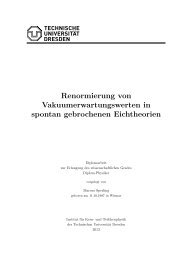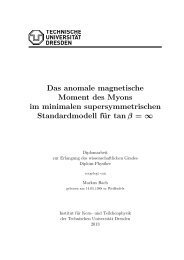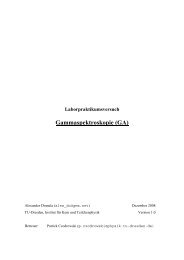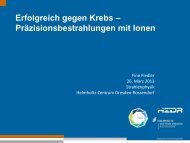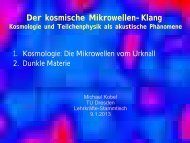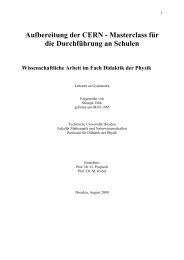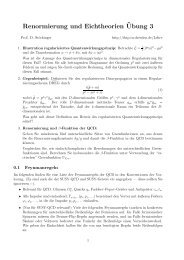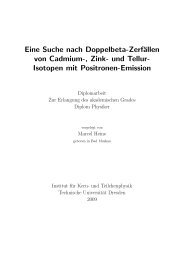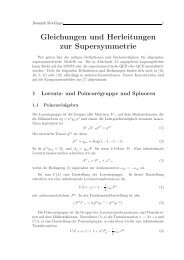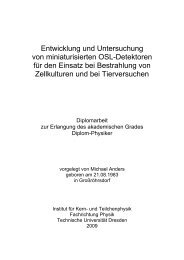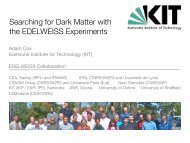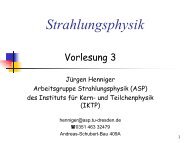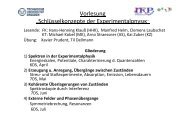a design study for a cobra upgrade to - Institut für Kern- und ...
a design study for a cobra upgrade to - Institut für Kern- und ...
a design study for a cobra upgrade to - Institut für Kern- und ...
You also want an ePaper? Increase the reach of your titles
YUMPU automatically turns print PDFs into web optimized ePapers that Google loves.
54 5 Scintilla<strong>to</strong>r <strong>upgrade</strong><br />
event ID track ID particle Ei Edep x process step<br />
6 1 gamma 500.00 0.00 31.83 compt 10<br />
6 1 gamma 202.62 0.00 31.55 compt 10<br />
6 1 gamma 131.54 0.00 15.92 compt 10<br />
6 1 gamma 130.54 0.00 0.00 trans 10<br />
6 4 e- 0.991 0.99 15.92 eIoni 10<br />
6 3 e- 71.09 71.09 31.55 eIoni 10<br />
6 2 e- 297.38 152.73 31.93 eBrem 10<br />
6 2 e- 108.59 108.59 31.90 eIoni 10<br />
6 5 gamma 36.06 1.56 25.24 phot 10<br />
6 6 e- 34.49 34.49 25.24 eIoni 10<br />
Table 5.1: Detailed output from simulation ”ScintBlock” of one 500 keV<br />
pho<strong>to</strong>n in NaI, whereas y and z values of interaction points are missing<br />
in this list.<br />
other) on a scintilla<strong>to</strong>r block with 1 m lateral length and 21 different<br />
width, ranging from 1 mm <strong>to</strong> 1 m was examined. Thereby pho<strong>to</strong>ns with<br />
10 different energies from 200 <strong>to</strong> 2000 keV were initialised. Due <strong>to</strong> the<br />
arguments from chapter 4.1.3—“Scintillating materials” only NaI, CsI,<br />
BGO and CWO crystal were considered.<br />
For every data file, the <strong>to</strong>tal amount of interacting pho<strong>to</strong>ns and the fullenergy<br />
events were counted.<br />
RESULTS<br />
In table 5.2 the peak and <strong>to</strong>tal absorption efficiency <strong>for</strong> scintilla<strong>to</strong>rs of<br />
different width <strong>for</strong> different pho<strong>to</strong>n energies, which was obtained with<br />
this simulation, is listed. The peak absorption efficiency is the efficiency<br />
<strong>for</strong> absorbing the full energy of the incident pho<strong>to</strong>n and the <strong>to</strong>tal<br />
absorption efficiency is the <strong>to</strong>tal efficiency of the initial pho<strong>to</strong>n <strong>for</strong> interacting<br />
with the scintilla<strong>to</strong>r material. This was mapped <strong>for</strong> incident<br />
1200 keV pho<strong>to</strong>ns, as can be seen in figure 5.1. The <strong>to</strong>tal and peak efficiencies<br />
of the four scintilla<strong>to</strong>rs are shown in A—“FIRST APPENDIX”<br />
in figure B.1 - B.7.<br />
NaI has the smallest density of these scintilla<strong>to</strong>rs and correspondingly<br />
the smallest absorption efficiency. CWO has higher density but a<br />
smaller effective a<strong>to</strong>mic number Zeff than BGO. This leads <strong>to</strong> different<br />
<strong>to</strong>tal and peak efficiencies <strong>for</strong> BGO and CWO. The efficiencies depend<br />
on the density and a<strong>to</strong>mic number of the absorber material and<br />
the energy of the initial pho<strong>to</strong>n.



